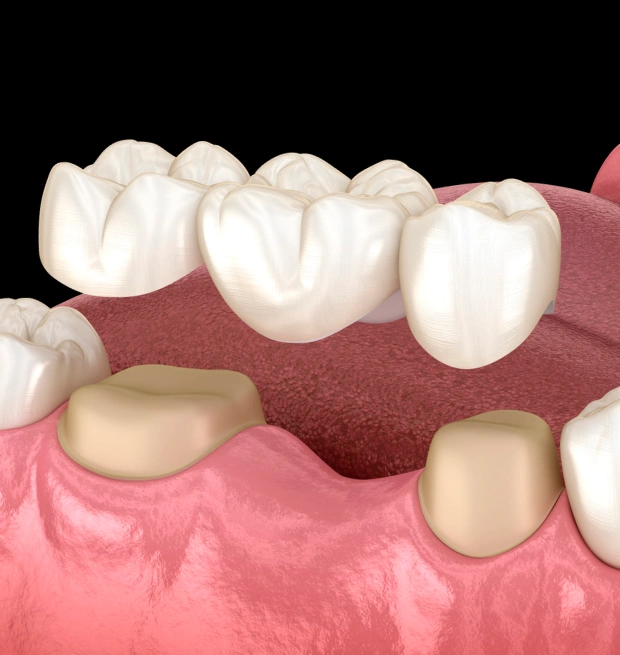
About Dental Bridges
A dental bridge is a reliable and durable solution for replacing missing teeth, providing a long-lasting option for filling in gaps. Unlike removable partial dentures that rely on existing teeth for support, a dental bridge is anchored in place by crowns on adjacent teeth or dental implants. This not only restores the natural appearance and function of the smile but also prevents teeth from shifting and maintains proper bite alignment.
The concept of a fixed dental bridge is not new and has been in use for centuries. Ancient civilizations used various materials such as animal and human teeth, bones, gold, and ivory to bridge the gaps in their smiles.
Fortunately, thanks to advancements in dental materials and technology, modern dental bridges are now available. These bridges are made from high-quality materials such as porcelain, porcelain fused to metal, and engineered ceramics like zirconia. They are not only more durable and long-lasting but also provide a more natural and aesthetically pleasing appearance.
Common Types of Dental Bridges
Fixed Traditional Bridge
Traditional fixed bridges require the preparation and crowning of teeth on both sides of a gap in the mouth to support artificial teeth known as "pontics." This design is reminiscent of a bridge over water, depending on sturdy pillars at each end for stability.
On the other hand, a cantilever fixed bridge is akin to a traditional fixed bridge but with the distinction that only one side of the pontic is connected to a dental crown for support.
Bridges Supported by Dental Implants
Dental implants are the most advanced method for replacing missing teeth, closely replicating the look, feel, and function of natural teeth. An implant-supported bridge is often the best option for care because it eliminates the need to prepare or involve adjacent natural teeth.
Similar to natural tooth roots, dental implants provide the necessary support for a bridge. Implant-supported bridges offer a versatile approach to rebuilding a complete smile, as strategically placed implants can support any number of replacement teeth. Additionally, dental implants prevent bone shrinkage that occurs when teeth are lost, helping to maintain normal facial contours.
At Flossophy Dental Studio, our mission is to help every patient achieve good oral health and a beautiful smile. We offer skilled and experienced care, utilizing advanced dental implant-based solutions to transform incomplete smiles into confident ones that look great and function well.
What You Can Anticipate When Receiving a Traditional Bridge
Fixed bridges are typically created over multiple visits. The process involves preparing the supporting teeth, taking impressions, placing a temporary bridge, and finally cementing the permanent restoration.
During the initial step, the dentist performs a comprehensive diagnostic workup to develop an appropriate treatment plan. For patients undergoing a traditional fixed bridge, the next step involves preparing the abutment teeth for full-coverage crowns. Depending on the number of teeth involved, an impression for the permanent bridge may be taken during this visit or the following one. In the interim, temporary crowns or a temporary bridge will be installed to safeguard the prepared teeth.
After tooth preparation, it is common to experience some sensitivity and gum soreness, which should diminish over time. However, temporary restorations may not fit as accurately as the final permanent crown or bridge, so you may still experience some sensitivity until the treatment is complete.
It is important to handle temporary restorations with care as they are not as durable as permanent ones. If your temporary bridge sustains damage or becomes dislodged, please retain it and contact our office to arrange a replacement appointment. Avoid trying to repair it yourself.
What to Expect When Getting an Implant-supported Bridge
The placement of dental implants is generally considered a minor surgical procedure that is done on an outpatient basis. The extent of the procedure depends on the type and number of implants needed, as well as any additional procedures required to prepare the supporting bone.
As your trusted partner in care, we will keep you well informed throughout the process. To ensure precise placement of your implant-supported bridge, we will take detailed diagnostic records, including 3D images of your jaws and the area involved.
Patient care and comfort are our top priorities. We aim to make every visit comfortable and stress-free. Before the procedure, we will discuss anesthesia options, sedation, and provide pre-op and post-op care instructions.
After placing the dental implants, they may take months to integrate with the bone. In some cases, a temporary bridge is placed on the same day for an immediate look. The permanent bridge is placed once healing and fusion are complete.

